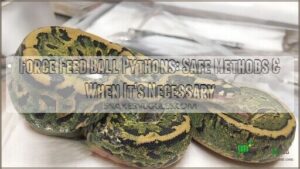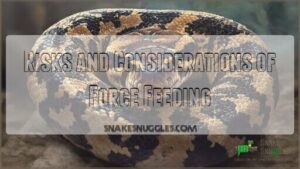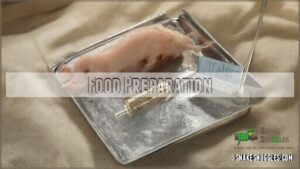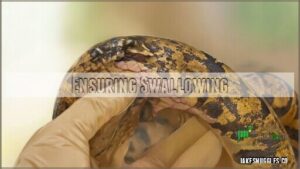This site is supported by our readers. We may earn a commission, at no cost to you, if you purchase through links.

Most feeding strikes resolve naturally with patience and proper husbandry tweaks. Before you even think about going down this road, try assist feeding methods and scent tricks that work with your snake’s instincts rather than against them.
Only consider this risky procedure when your python’s lost 15-20% of body weight and you’ve exhausted safer options first. Force feeding stresses your snake enormously and can cause serious injury if you don’t know what you’re doing.
Table Of Contents
- Key Takeaways
- Understanding Ball Python Feeding Behavior
- When is Force Feeding Necessary?
- Risks and Considerations of Force Feeding
- Preparing for Force Feeding
- Step-by-Step Force Feeding Technique
- Aftercare Following Force Feeding
- Alternatives to Force Feeding
- Preventing The Need for Force Feeding
- Monitoring Health During Feeding Strikes
- When to Seek Veterinary Assistance
- Frequently Asked Questions (FAQs)
- What to do if a ball python refuses to eat?
- Can you power feed a ball python?
- How to feed a stubborn snake?
- How do you get a stressed ball python to eat?
- Is it OK to force feed a ball python?
- How do you feed a stubborn ball python?
- How to feed a snake that won’t eat?
- Should you feed a ball python?
- Are ball pythons fussy eaters?
- Can ball pythons eat frozen prey?
- Conclusion
Key Takeaways
- You should only force feed as a last resort when your ball python has lost 15-20% of its body weight and you’ve exhausted safer feeding methods like assisted feeding and scent enhancement techniques.
- You’ll need proper equipment and technique, including sterilized feeding tools, appropriately sized prey, and gentle handling methods to avoid serious injuries like mouth trauma or esophageal tears.
- You must monitor your snake closely after force feeding for signs of regurgitation and provide optimal temperature and humidity conditions while avoiding unnecessary handling during recovery.
- You can prevent most feeding issues through proper husbandry by maintaining correct temperatures (88-92°F basking, 78-80°F cool side), 50-60% humidity, and addressing underlying health issues before they become critical.
Understanding Ball Python Feeding Behavior
You’ll need to understand your ball python’s natural feeding patterns before considering force feeding, as these snakes can be notoriously picky eaters who refuse meals for weeks or even months without serious health consequences.
Ball pythons are ambush predators in the wild, which means they’re naturally programmed to wait patiently for the perfect meal rather than eat on your preferred schedule.
Natural Feeding Habits
Ball pythons exhibit fascinating natural feeding behaviors that every keeper should understand.
Understanding your python’s wild instincts is the key to solving feeding mysteries and avoiding dangerous interventions.
Their wild diet consists primarily of small mammals and birds, with hunting strategies that rely heavily on ambush tactics during twilight hours.
Understanding these natural feeding instincts helps you provide better care:
- Prey preference varies by gender – males typically hunt birds while females target mammals
- Feeding frequency naturally occurs every 1-3 weeks depending on prey availability
- Natural cues like darkness and warmth trigger their hunting response
- Scent detection drives their feeding behavior more than visual stimulation
Reasons for Feeding Refusal
Your python’s feeding refusal isn’t always stubbornness—it’s often communication.
Environmental stressors like relocation, temperature fluctuations, or cage changes trigger snake feeding problems.
The shedding cycle naturally suppresses appetite, while improper husbandry creates ongoing stress.
Wild-caught specimens may reject unfamiliar prey due to prey preference, and dehydration plus parasites compound the issue.
Health concerns manifest as illness signs through appetite loss.
Breeding season also affects feeding behavior.
Understanding these triggers helps you distinguish between normal reluctance and serious husbandry problems requiring intervention.
When is Force Feeding Necessary?
You’ll need to think about force feeding when your ball python has lost 15-20% of its body weight during an extended feeding strike.
When underlying health issues prevent normal eating, this intervention becomes necessary.
You’ll need to rule out environmental problems and try alternative feeding methods first, as force feeding is truly a last resort for keeping your snake healthy.
Weight Loss Thresholds
Monitoring weight loss becomes paramount when your ball python refuses meals for extended periods.
Weight Loss Indicators typically signal concern when your snake drops 15-20% of body weight. Body Condition Scoring helps identify Malnutrition Signs like visible ribs or muscle wasting. Threshold Guidelines suggest intervention before critical health decline occurs.
- Track weight every 2-4 weeks using digital scales for accuracy
- Document feeding history alongside weight measurements for patterns
- Compare current weight against age-appropriate growth charts consistently
Health Concerns
Recognizing serious health complications helps determine when forcefeeding becomes unavoidable. You’ll notice dehydration through sunken eyes and sticky saliva. Parasites cause weight loss despite normal appetite. Watch for mouth injury signs like swelling or discharge.
| Health Issue | Warning Signs |
|---|---|
| Dehydration | Sunken eyes, sticky saliva |
| Parasites | Weight loss, lethargy |
| Mouth Injury | Swelling, discharge |
| Regurgitation | Undigested food, stress |
Serious risks include esophageal tears, internal damage, and aspiration pneumonia. Feeding aversion often develops after traumatic experiences. Maintaining proper snake feeding health is paramount for preventing these issues. It is crucial for overall health to avoid forcefeeding and traumatic experiences.
Risks and Considerations of Force Feeding
You’re considering force feeding your ball python, but this procedure carries serious risks that you can’t ignore.
Force feeding creates extreme stress for your snake and can cause physical injuries like mouth trauma, throat damage, or digestive problems if you don’t use proper technique.
Stress on The Snake
When force feeding becomes unavoidable, you’re basically putting your snake through a nightmare scenario. This invasive procedure triggers intense Snake Stress Factors and amplifies Handling Stress beyond normal levels.
Your python’s fight-or-flight response kicks into overdrive, potentially causing long-term behavioral changes.
Feeding Stressors multiply during forced intervention, making Stress Reduction Tips vital for protecting snake wellbeing throughout this traumatic process, which involves managing Feeding Stressors.
Potential Physical Damage
Beyond the psychological stress lies serious physical trauma that you can’t ignore.
Force feeding creates genuine risks that could permanently harm your snake if you’re not careful:
- Mouth injuries from forcing jaws open can cause lasting damage to delicate tissue
- Esophageal tears from aggressive food insertion may lead to internal bleeding
- Digestive issues including aspiration and organ damage from improper technique
These complications often outweigh the benefits, making force feeding truly dangerous.
To minimize risks, it’s paramount to understand the importance of Proper Handling during the force feeding process.
Preparing for Force Feeding
Before you attempt force feeding, you’ll need to gather the right equipment and prepare your snake’s food properly.
Having everything ready beforehand reduces stress for both you and your python, since you won’t be fumbling around for supplies while handling your snake.
Equipment Needed
Successfully force-feeding your ball python requires proper equipment preparation. You’ll need sterilized feeding tongs or forceps with non-slip grips, a soft feeding tube (3-4mm diameter), and a feeding syringe for liquid nutrition.
Don’t forget surgical lubricant for smoother insertion and disposable gloves for hygiene. Having the right tools makes this stressful procedure safer for both you and your snake.
Understanding the reasons for feeding refusal can help you prepare and potentially avoid the need for force-feeding.
Food Preparation
Before attempting force feeding, proper prey preparation sets the stage for success. Choose appropriately sized prey—roughly matching your snake’s thickest section.
Thawed prey should be completely defrosted in warm water, then warmed to 110°F for ideal meal temperature. Prey warming and thorough drying prevent bacterial growth.
Food scenting with chicken broth or rodent bedding can trigger feeding responses. Remember, prey sizing matters—too large risks injury.
These feeding techniques form the foundation of safe forcefeeding techniques.
Step-by-Step Force Feeding Technique
Once you’ve prepared your equipment and food, you’ll need to follow a precise sequence to safely force feed your ball python.
This process requires steady hands, patience, and careful attention to your snake’s body language throughout each step.
Proper Handling
Proper handling during force feeding requires balancing necessity and safety. Safe restraint means holding your ball python behind the head with gentle but firm control, supporting the body lightly. This handling technique minimizes stress while preventing sudden movements that could cause esophagus damage.
Reducing stress through proper restraint techniques is vital for successful assisted feeding:
- Recognizing signals of distress helps you adjust your grip immediately
- Handling frequency should be minimal – only absolutely necessary
- Avoiding bites requires confident, steady movements throughout the process
- Clean hands eliminate food scents that might trigger defensive responses
- Controlled environment reduces external stressors during forcefeeding techniques
Using the right reptile restraint tools can greatly enhance your ability to handle the snake safely and effectively.
Inserting The Food
When your ball python’s feeding strike persists, you’ll need to carefully open its mouth using gentle pressure on the jaw hinges.
Insert pre-killed prey head-first with long-handled forceps, pushing steadily but slowly.
Use assisted feeding techniques to guide food past the glottis into the esophagus, avoiding tube feeding complications.
| Food Insertion Techniques | Prey Placement Methods | Snake Mouth Opening |
|---|---|---|
| Forceps-guided insertion | Head-first positioning | Gentle jaw pressure |
| Steady, controlled pushing | Proper angle alignment | Credit card method |
| Avoid rushing the process | Monitor resistance levels | Maintain snake security |
Ensuring Swallowing
After food insertion, guide the prey past the glottis using gentle massage movements down your snake’s throat. Don’t force it—let gravity assist the swallowing process naturally.
If your python resists, pause until it relaxes completely. Watch for regurgitation signs and breathing difficulties.
Esophageal guidance requires patience; rushing increases stress and injury risk. These swallowing techniques during assist feeding help overcome feeding strikes while ensuring your snake’s safety throughout the delicate procedure.
Aftercare Following Force Feeding
After you’ve completed the force feeding process, your snake’s recovery becomes your top priority, and the next few hours will determine whether the procedure was successful.
You’ll need to watch carefully for signs of regurgitation while providing the perfect environment for digestion, because even a small mistake in aftercare can undo all your careful work.
Monitoring for Regurgitation
Once you’ve completed the force-feeding process, watch your ball python like a hawk for regurgitation. This serious complication can occur within hours and requires immediate attention.
Look for these regurgitation causes and warning signs:
- Abnormal mouth movements, neck stretching, visible food particles in the enclosure, or sudden restlessness
Identifying regurgitation early makes all the difference in your snake’s recovery.
Snake regurgitation often stems from stress, improper technique, or underlying snake health issues. Quick recognition of feeding problems helps you respond appropriately and prevents further complications from developing.
Providing Optimal Environment
Recovery requires ideal habitat temperature between 78-88°F with proper gradients.
Maintain your enclosure at 50-60% humidity using a reliable hygrometer. Create a stress-free sanctuary with snug hide boxes on both warm and cool sides.
Fresh water should always be available. Skip environmental enrichment during recovery—your snake needs peace, not stimulation.
Proper snake husbandry now determines whether your force-feeding efforts succeed or fail miserably.
Alternatives to Force Feeding
Before you resort to force feeding your ball python, you’ll want to try several gentler methods that can often coax a reluctant snake into eating naturally.
These alternative techniques work with your python’s instincts rather than against them, reducing stress while still addressing feeding concerns.
Assist Feeding Methods
Success with assist feeding comes down to patience and technique. These feeding methods offer a gentler alternative to forcefeeding when your ball python shows feeding refusal.
Unlike aggressive intervention, assisted feeding helps your snake begin the natural process:
- Use tongs feeding to gently place prey at the snake’s mouth opening
- Allow appetite stimulation through natural prey preparation and scent enhancement
- Guide assisted prey placement while letting your python control swallowing
This approach reduces stress while addressing snake feeding refusal causes through supportive feeding techniques. By understanding proper Prey Presentation Techniques, you can further enhance the effectiveness of assist feeding methods.
Scent Enhancement Techniques
Sometimes ball pythons need a little convincing to eat, and scent enhancement techniques can work wonders. Try scenting your prey by rubbing it with gerbil bedding or chick scent to trigger feeding stimulation.
Braining exposes brain matter for stronger aroma enhancement, while heating prey creates appealing odor tricks. These scent tricks often succeed where force feeding fails, making your snake’s next meal feel like their own decision.
Don’t forget proper prey size matters too.
For more stubborn cases, exploring various snake feeding scents can provide additional solutions to stimulate appetite, using techniques such as scenting your prey and utilizing different feeding stimulation methods.
Preventing The Need for Force Feeding
You can avoid force feeding your ball python by maintaining proper temperatures, humidity levels, and feeding schedules that match their natural behavior.
Most feeding strikes happen because something’s off in their environment, so getting the basics right prevents the stress and health risks that come with forced feeding.
Complete concepts are key to avoiding this issue.
Optimal Husbandry Practices
Rather than forcing food down your snake’s throat, smart habitat maintenance prevents most feeding strikes. Your ball python’s appetite depends heavily on environmental control – it’s like setting the dinner table properly.
- Temperature regulation: Maintain 88-92°F basking spot with 78-80°F cool side
- Humidity management: Keep levels between 50-60% consistently
- Lighting considerations: Provide 12-hour day/night cycles
- Python feeding schedule: Follow age-appropriate intervals for suitable reptile care
Addressing Underlying Issues
Beyond ideal husbandry, you’ll need to tackle the root problems causing feeding strikes. Environmental Factors like incorrect temperatures or humidity often trigger refusal. Health Checks reveal parasites, respiratory infections, or other Medical Conditions that kill appetite. Stress Reduction through proper hiding spots and minimal handling works wonders.
| Issue Category | Common Solutions |
|---|---|
| Parasites | Regular deworming, fecal exams |
| Respiratory Problems | Humidity adjustment, vet treatment |
| Stress | More hides, reduce handling |
| Poor Appetite | Scenting prey, braining techniques |
| Nutritional Deficiencies | Supplement guidance, diet variety |
Veterinary consultation prevents health deterioration before force-feeding becomes necessary.
Monitoring Health During Feeding Strikes
You’ll need to track your ball python’s weight and hydration levels closely during feeding strikes.
To determine when intervention becomes necessary, regular monitoring helps you distinguish between normal seasonal fasting and concerning health decline that might require force feeding.
Weight Tracking
During feeding strikes, weight monitoring becomes your most reliable health indicator. Weigh your ball python weekly using a digital scale and maintain detailed records.
Healthy snakes maintain stable snake weight or show gradual increases, while rapid weight loss signals serious concern. Track your snake’s growth rate to assess overall body condition – it’s like reading your pet’s health report card.
Use these measurements to adjust your feeding frequency and develop effective snake feeding solutions. Remember, weight changes might reflect hydration levels or simple food preferences, so stay observant and adjust your feeding schedule accordingly.
Hydration Assessment
Checking your ball python’s hydration status during feeding strikes can prevent serious health complications. Watch for dehydration signs like sunken eyes, wrinkled skin, and sticky mouth membranes.
These indicators signal your snake needs immediate attention.
While hydration methods like subcutaneous fluid therapy exist, they’re best handled by veterinarians who understand proper snake hydration protocols and safe administration techniques.
Maintaining proper hydration levels is paramount for your snake’s overall health and digestion.
When to Seek Veterinary Assistance
You’ll know it’s time to call a vet when your ball python shows concerning signs like rapid weight loss, dehydration, or unusual behavior that goes beyond typical feeding strikes.
Professional veterinary assistance becomes essential if you’re unsure about force feeding techniques or if your snake hasn’t eaten for several months despite your best efforts.
Signs of Serious Health Issues
When your ball python’s feeding strike drags on, certain warning signs demand immediate attention. Watch for rapid weight loss exceeding 10% of body mass, sunken eyes, or wrinkled skin indicating severe dehydration.
Rapid weight loss, sunken eyes, or wrinkled skin signal urgent dehydration—act fast to save your ball python’s health.
Abnormal discharges, visible parasites, persistent lethargy, or repeated regurgitation are serious health red flags.
- Your snake’s life hangs in the balance when these symptoms appear—don’t gamble with delayed treatment
Weight tracking becomes imperative during extended strikes—these dehydration symptoms and lethargy indicators can escalate quickly.
Understanding regurgitation causes and recognizing these warning signs early makes the difference between recovery and tragedy. Trust your instincts and seek veterinary assistance immediately when something feels wrong.
Professional Force Feeding
When your snake’s survival hangs in the balance, professional guidance becomes non-negotiable. Veterinarians employ specialized force feeding methods with surgical precision, utilizing sterile feeding tube safety protocols and expert snake handling techniques.
They’ll master prey preparation tips while ensuring proper feeding interventions. Remember, forcefeeding represents a last resort requiring veterinary guidance. Proper care includes understanding the importance of Proper Veterinary Care for maintaining your snake’s overall health.
| Aspect | Professional Approach | Home Attempt |
|---|---|---|
| Equipment | Sterile surgical tools | Basic household items |
| Technique | Medical precision | Trial and error |
| Safety | Minimized trauma risk | Potential injury |
Frequently Asked Questions (FAQs)
What to do if a ball python refuses to eat?
Like a stubborn teenager at dinner, your ball python might refuse food due to stress, wrong temperatures, or seasonal changes.
Check husbandry first, guarantee proper heat gradients, reduce handling, and try different prey sizes before panicking.
Can you power feed a ball python?
Yes, you can power feed a ball python, but it’s extremely risky and stressful.
Only attempt this last-resort method under veterinary guidance when your snake hasn’t eaten for dangerously long periods.
How to feed a stubborn snake?
Try warming prey to 110°F, offering during twilight hours, and using scent techniques like rubbing with rodent bedding.
Check husbandry conditions, reduce handling stress, and guarantee proper temperatures before considering veterinary consultation.
How do you get a stressed ball python to eat?
Contrary to popular belief, stressed ball pythons won’t magically start eating through coercion.
You’ll need patience—reduce handling, guarantee proper temperatures, offer smaller prey in darkness, and create a secure hiding spot.
Sometimes less intervention works better.
Is it OK to force feed a ball python?
Force feeding should only be your absolute last resort when your ball python hasn’t eaten for months and faces serious health risks.
It’s stressful and dangerous, requiring veterinary guidance to avoid injuries.
How do you feed a stubborn ball python?
Address environmental issues first—check temperatures, humidity, and hide spots.
Switch prey types or sizes, try scenting with mouse bedding, and feed during evening hours when they’re naturally active.
Patience beats force every time.
How to feed a snake that won’t eat?
Check environmental conditions first—temperature, humidity, and hiding spots affect appetite.
Offer appropriately-sized prey using feeding tongs.
If issues persist beyond several weeks, consult a reptile veterinarian to rule out underlying health problems.
Should you feed a ball python?
Wondering if you’re doing right by your scaly friend?
Yes, you should definitely feed your ball python regularly. They need consistent meals every 7-14 days depending on age to stay healthy and thrive.
Are ball pythons fussy eaters?
Yes, ball pythons can be notoriously picky eaters.
They’ll often refuse meals for weeks or even months, especially during seasonal changes, stress, or if environmental conditions aren’t perfect for their comfort.
Can ball pythons eat frozen prey?
Nearly 90% of captive ball pythons thrive on frozen-thawed prey.
You can absolutely feed your snake frozen mice or rats—just thaw them properly first.
It’s safer than live prey and eliminates injury risks. It’s safer than live prey and eliminates injury risks.
Conclusion
Remember, force feeding ball pythons is like performing surgery with a sledgehammer – sometimes necessary, but always requiring extreme caution.
You’ve learned the warning signs, proper techniques, and critical aftercare steps that can mean the difference between saving your snake and causing harm.
Most feeding strikes resolve naturally with patience and improved husbandry. When you do need to force feed ball pythons, work methodically, monitor closely, and don’t hesitate to consult an exotic veterinarian for guidance.


















